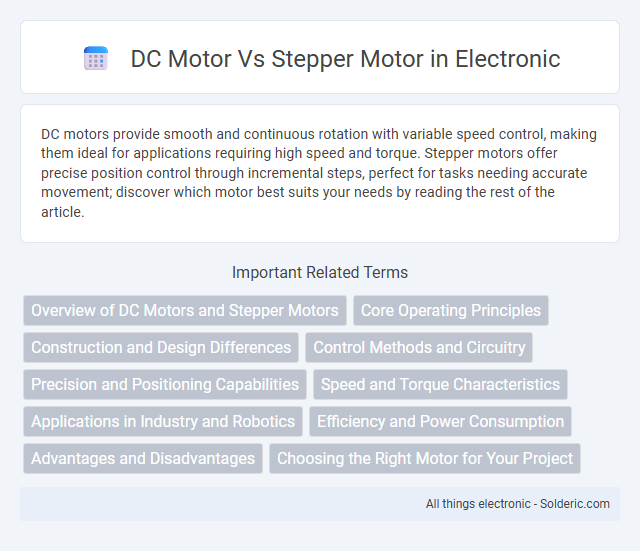DC motors provide smooth and continuous rotation with variable speed control, making them ideal for applications requiring high speed and torque. Stepper motors offer precise position control through incremental steps, perfect for tasks needing accurate movement; discover which motor best suits your needs by reading the rest of the article.
Comparison Table
| Feature | DC Motor | Stepper Motor |
|---|---|---|
| Operation | Continuous rotation with variable speed | Discrete steps with precise position control |
| Control | Voltage or current control | Pulse input for step control |
| Torque | High starting torque, decreases with speed | High holding torque at standstill |
| Accuracy | Low positional accuracy | High positional accuracy (step angle) |
| Complexity | Simple design, easy to control | Complex control, requires driver circuitry |
| Cost | Generally lower cost | Higher cost due to control electronics |
| Applications | Fans, pumps, conveyors, robotics | 3D printers, CNC machines, precision positioning |
| Speed Range | Wide speed range, smooth acceleration | Limited speed range, stepwise movement |
| Feedback | Generally requires external sensor | Open-loop control possible without sensor |
Overview of DC Motors and Stepper Motors
DC motors convert direct current electrical energy into mechanical rotation, offering smooth and continuous motion suitable for applications requiring variable speed and torque control. Stepper motors, on the other hand, move in precise, fixed increments by energizing coils sequentially, making them ideal for applications demanding accurate positioning and repeatability. Your choice between DC and stepper motors depends on whether you prioritize continuous rotation or precise stepping in your project.
Core Operating Principles
DC motors operate by converting direct electrical current into mechanical rotation through the interaction of magnetic fields generated by a rotor and stator. Stepper motors function by dividing a full rotation into equal steps, controlled by electrical pulses that sequentially energize coils, allowing precise angular position control. Your choice depends on whether continuous rotation or exact positioning is required.
Construction and Design Differences
DC motors feature a simple construction with a rotor, stator, commutator, and brushes to allow continuous rotation, while stepper motors have multiple coils arranged in phases that control precise rotor position without brushes. The design of DC motors enables smooth speed variation, whereas stepper motors are designed for incremental movement with distinct step angles, enhancing position accuracy. Stepper motors often incorporate a toothed stator and rotor to enable magnetic detenting and hold torque, contrasting with the uniform rotor design found in typical DC motors.
Control Methods and Circuitry
DC motors utilize simple control methods involving variable voltage or PWM (Pulse Width Modulation) signals to regulate speed and direction through H-bridge circuits for efficient torque management. Stepper motors rely on precise digital pulses generated by stepper drivers to control position and speed, with circuitry that includes multi-phase coils energized sequentially to achieve accurate rotational steps. The complexity of stepper motor control circuitry allows for fine incremental movement, contrasting with the more straightforward analog or PWM control schemes used in DC motors.
Precision and Positioning Capabilities
Stepper motors provide superior precision and positioning capabilities due to their ability to move in discrete steps, enabling exact angular displacement without feedback systems. DC motors rely on continuous rotation and typically require external encoders or sensors for precise position control, making them less inherently accurate than stepper motors. This inherent stepwise movement makes stepper motors ideal for applications demanding precise control, such as 3D printers and CNC machines.
Speed and Torque Characteristics
DC motors offer variable speed control with smooth operation across a wide range, providing high torque at low speeds suitable for continuous rotation applications. Stepper motors deliver precise position control with consistent torque at low speeds but experience reduced torque at higher speeds due to their discrete step nature. Speed and torque in DC motors depend on voltage and current, whereas stepper motors rely on step rate and driver current for performance optimization.
Applications in Industry and Robotics
DC motors are widely used in industrial applications requiring continuous rotation and variable speed control, such as conveyor belts, pumps, and fans. Stepper motors excel in robotics and precision machinery where accurate position control and repeatability are critical, including 3D printers, CNC machines, and robotic arms. Choosing your motor depends on whether smooth speed variation or precise positioning better suits your automation or robotic system.
Efficiency and Power Consumption
DC motors generally offer higher efficiency with continuous rotation, consuming less power for steady-speed applications due to their simple construction and constant voltage operation. Stepper motors consume more power as they draw current in pulses to maintain precision positioning and torque, often leading to increased heat generation and lower overall efficiency. Efficiency in DC motors can reach up to 85-90%, while stepper motors typically operate around 40-70%, impacting their suitability for power-sensitive applications.
Advantages and Disadvantages
DC motors offer smooth rotation and variable speed control, making them ideal for applications requiring continuous motion and high torque at variable speeds. Stepper motors provide precise position control and repeatability, which is beneficial for tasks requiring accurate incremental movement, but they tend to produce more noise and less torque at high speeds. Your choice depends on whether you prioritize continuous rotation efficiency with DC motors or precise positioning capabilities with stepper motors.
Choosing the Right Motor for Your Project
Choosing the right motor for your project depends on factors such as precision, speed control, and torque requirements. DC motors offer smooth continuous rotation and high-speed operation, making them ideal for applications requiring variable speed and high power. Stepper motors provide precise position control and repeatability, perfect for projects demanding exact movements and incremental steps.
DC Motor vs Stepper Motor Infographic

 solderic.com
solderic.com